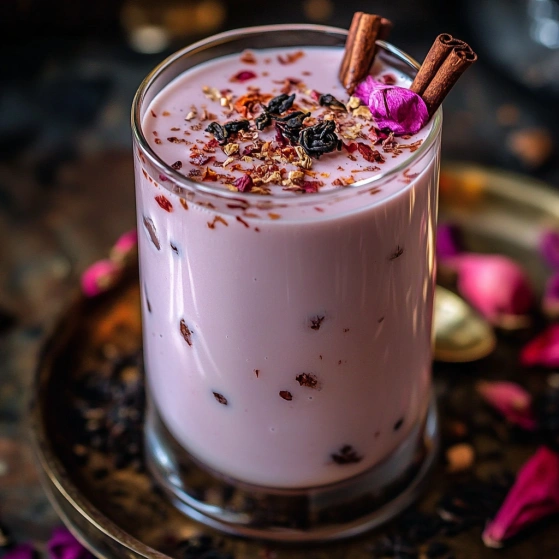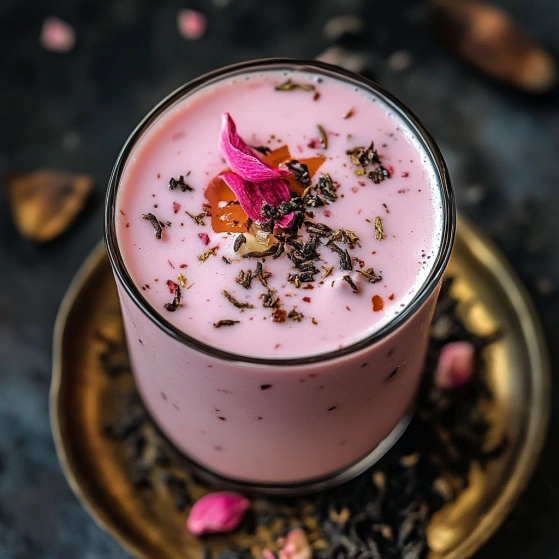 Pin it
Pin it
This remarkable Kashmiri Pink Chai transforms from vibrant emerald to a stunning pink hue through a fascinating chemical reaction, creating a drink that's as beautiful as it is delicious. This ancient beverage from the Himalayan valleys offers a completely different chai experience than what most Westerners are familiar with.
I discovered this recipe while researching traditional Himalayan beverages and was mesmerized by both the unusual preparation method and the striking color change. The first time I served it at a dinner party, my guests couldn't stop talking about it.
Ingredients
- 4 cups Water: provides the base for extracting all the flavors
- 2 tbsp Kashmiri/Himalayan green tea: creates the distinctive color transformation look for tea labeled as "noon chai" for authenticity
- 1/2 tsp Baking soda: the key catalyst that creates the chemical reaction for the signature pink color
- 1-2 Star anise: adds a subtle licorice undertone that balances the richness
- 2 Cardamom pods: crushed these provide the distinctive floral notes traditional to Kashmiri cuisine
- 1 Cinnamon stick: adds warmth and subtle sweetness choose Ceylon cinnamon for a more delicate flavor
- 1/4 tsp Salt: enhances all the flavors and is traditional in Kashmiri tea preparation
- 2 cups Whole milk: creates richness and creaminess that balances the strong tea
- Sugar or honey: to taste traditionally quite sweet, but adjust to your preference
- Crushed nuts like pistachios or almonds: optional but add texture and visual appeal
Step-by-Step Instructions
- Brew The Base:
- Bring the water to a boil in a heavy-bottomed saucepan. Add the green tea leaves and let them boil vigorously for about 5 minutes. The liquid will turn a deep brownish-green as the tea releases its tannins and oils.
- Create The Chemical Reaction:
- Add the baking soda and stir well. Watch as the tea transforms almost magically from green to a deep reddish-burgundy color. This fascinating reaction occurs as the alkaline baking soda interacts with the tea's compounds. Continue boiling for another 2 minutes to complete the transformation.
- Infuse The Spices:
- Add the star anise, crushed cardamom pods, and cinnamon stick. Allow these spices to boil with the tea for one full minute, releasing their essential oils into the mixture. The aroma will become noticeably more complex and fragrant.
- Concentrate The Flavors:
- Lower the heat to a gentle simmer and allow the mixture to reduce slowly for 20-30 minutes, uncovered. The volume should decrease by approximately half, concentrating the flavors significantly. The color will deepen to an intense burgundy.
- Season With Salt:
- Add the salt and stir thoroughly. In Kashmiri cuisine, this small amount of salt creates a fascinating flavor counterpoint that enhances the tea's complex notes without making it taste salty.
- Transform With Milk:
- Pour in the whole milk and increase the heat again. Stir constantly in a figure-eight motion to prevent the milk from scalding. As the mixture heats and the milk proteins interact with the tea, you'll witness the second magical transformation as the color shifts from burgundy to a beautiful dusty pink.
- Strain And Serve:
- Once the chai reaches a rolling boil and displays its signature pink color, remove from heat. Pour through a fine-mesh strainer into prewarmed teacups or a serving pot to remove all the tea leaves and spice pieces.
- Sweeten And Garnish:
- Add sugar or honey to taste, stirring until completely dissolved. Traditional Kashmiri chai tends to be quite sweet, but adjust according to your preference. Top with a sprinkling of crushed pistachios or almonds if desired for textural contrast and visual appeal.
 Pin it
Pin it
The baking soda is truly the magical ingredient in this recipe. The first time I made this chai, I was skeptical about adding it, but witnessing the dramatic color transformation was like watching a science experiment unfold in my kitchen. My Pakistani neighbor confirmed this was exactly how her grandmother made it back home.
The Cultural Significance
Kashmiri Pink Chai, also known as "Noon Chai" or "Gulabi Chai," holds deep cultural importance across Kashmir and parts of Northern Pakistan. Traditionally served at celebrations and family gatherings, it represents hospitality and community bonds. In Kashmiri weddings, serving this tea symbolizes the joining of families. The preparation is often a communal activity with techniques passed down through generations, making this more than just a beverage but a living cultural tradition.
Troubleshooting Your Pink Chai
If your chai isn't turning pink, there are several potential issues. First, check that you're using enough baking soda, as this catalyzes the color change. Second, ensure you're simmering the tea long enough before adding milk. The concentration phase is crucial for color development. Finally, water quality can affect the reaction, with harder water sometimes inhibiting the color transformation. If all else fails, a tiny drop of beetroot juice can enhance the pink color naturally without affecting flavor.
Serving Traditions
In Kashmir, Pink Chai is traditionally served in samovars at special gatherings. The tea is poured from height into the cup, creating a frothy top layer considered desirable. While modern kitchens might not have samovars, you can recreate this effect by pouring the tea between two containers several times before serving. Traditional accompaniments include crispy salted biscuits or sweet bread like sheermal. For an authentic experience, serve in small cups rather than large mugs, encouraging multiple refills as a gesture of continued hospitality.
Seasonal Adaptations
During summer months, Kashmiri Pink Chai can be transformed into a refreshing iced version. After preparing as directed, allow the chai to cool completely before refrigerating. Serve over ice with a splash of rose water for an extra floral note. In winter, increase the warming spices by adding a few black peppercorns or a small piece of dried ginger during the simmering stage. These adaptations honor the traditional preparation while accommodating seasonal preferences.
 Pin it
Pin it
Frequently Asked Questions
- → Why does Kashmiri Pink Chai turn pink?
The chai turns pink due to a chemical reaction between the baking soda, green tea, and milk. The baking soda first turns the tea a deep red color, and when milk is added and boiled together, it transforms into the characteristic pink shade.
- → Can I use regular green tea for Kashmiri Pink Chai?
Yes, you can use regular green tea, though authentic Kashmiri or Himalayan green tea will provide the most traditional flavor. The baking soda and preparation method are more crucial for achieving the signature pink color than the specific tea variety.
- → Why is salt added to Kashmiri Pink Chai?
Salt is a traditional component that balances the flavors and enhances the aromatic spices. It creates the characteristic savory-sweet profile that distinguishes Kashmiri Pink Chai from other chai varieties. The small amount adds depth rather than making the chai taste salty.
- → Can I make Kashmiri Pink Chai without dairy milk?
While traditional Kashmiri Pink Chai uses whole milk for the richest flavor and color reaction, you can experiment with full-fat plant-based alternatives. However, the chemical reaction that creates the pink color works best with dairy milk, so the color might be less pronounced with alternatives.
- → How long does it take to make authentic Kashmiri Pink Chai?
Authentic Kashmiri Pink Chai takes approximately 45-60 minutes to prepare properly. The lengthy simmering process (20-30 minutes) is essential for developing the concentrated flavor and color that makes this chai special.
- → What foods pair well with Kashmiri Pink Chai?
Kashmiri Pink Chai pairs wonderfully with traditional breads like lavasa or girda, dried fruits, nuts, or light pastries. In Kashmir, it's often enjoyed with traditional breakfast items or as an afternoon refreshment with savory snacks.
